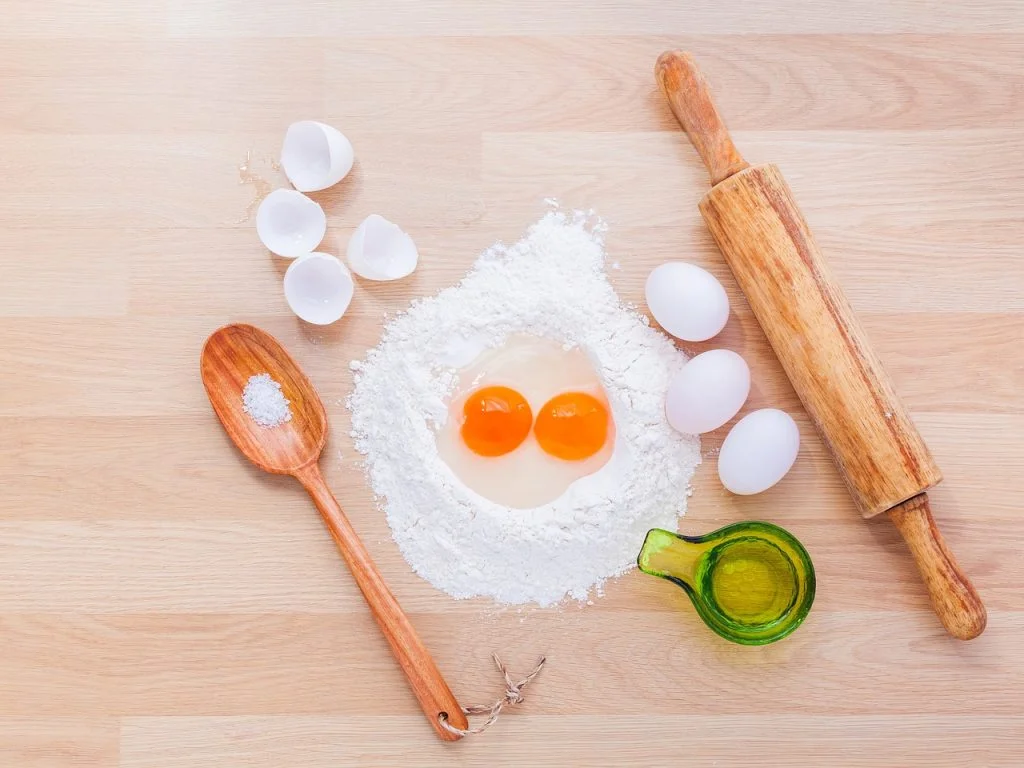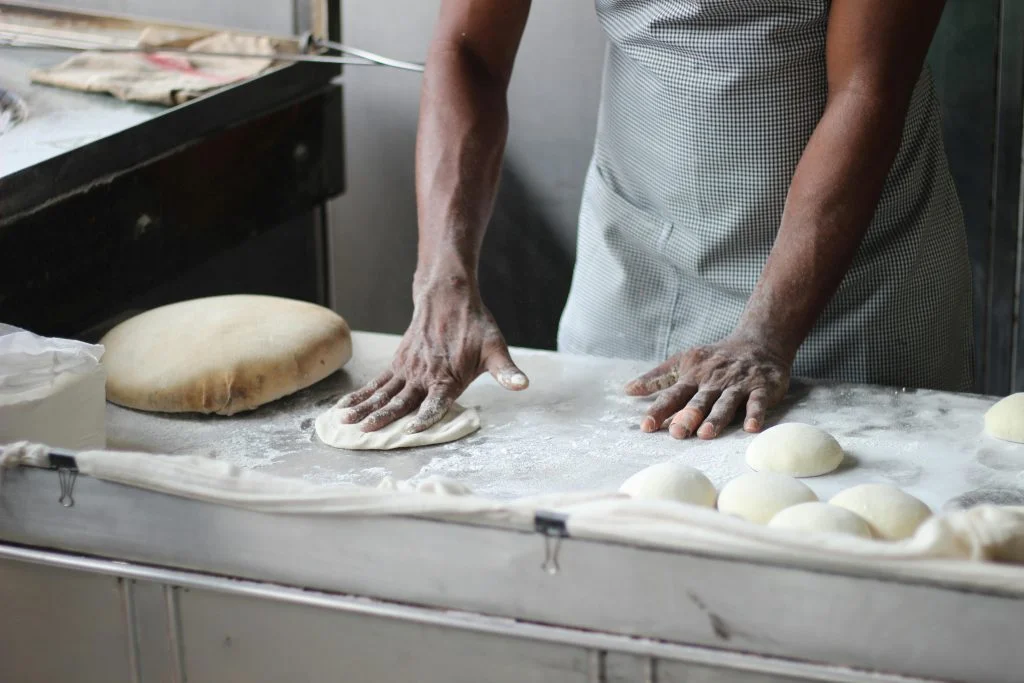Ah, the sweet, sweet world of baking, where my adventures have led to both triumphs and… let’s call them ‘learning experiences‘. Did you know there’s more to baking than just following a recipe? It’s a science, an art, and sometimes, a wild guessing game (did I add salt or sugar?).
Through years of floury encounters and icing escapades, I’ve gathered 50 fantastic baking facts that will not only up your game but also provide great trivia for your next dinner party. Are you ready to find out why your cookies sometimes resemble hockey pucks more than treats? Let’s dive in!
Baking cookies is comforting, and cookies are the sweetest little bit of comfort food.
Sandra Lee
Baking Facts
Ready, set, bake! Uncover the mouth-watering world of baking fun facts. Stay sharp, as there’s a quiz at the bottom of this article to put your knowledge to the test!
- Baking powder and baking soda are not interchangeable; baking powder is a combination of baking soda and an acid, usually cream of tartar.
- Proofing dough means allowing it to rise before baking, which is crucial for the development of flavor and texture.
- Butter temperature can drastically affect the texture of baked goods; room temperature butter is often ideal for creamy textures.
- Preheating the oven is essential for achieving the correct baking temperature as soon as the food is placed inside.
- Using a scale for measuring ingredients is more accurate than using cups and spoons, leading to more consistent results.
- “Blind baking” refers to baking a pie crust or pastry without the filling to prevent it from becoming soggy.
- Yeast is a living organism; too hot water can kill it, while too cold water won’t activate it properly in doughs.
- Folding in ingredients gently is key to keeping air in batters, especially for light and airy cakes.
- Overmixing batter can develop too much gluten, leading to tough cakes or muffins.
- Autolyse is a technique where flour and water are mixed and rested before adding other ingredients to develop gluten naturally.
- Room temperature eggs mix more evenly into batters, resulting in a more uniform texture.
- Altitude affects baking; higher altitudes often require adjustments in leavening and liquids.
- Using aluminum foil or parchment paper on baking sheets can make cleanup easier and prevent sticking.

- Sifting flour helps to aerate it, leading to lighter cakes and pastries.
- Gluten-free baking often requires a blend of different flours to replicate the texture of gluten-containing flours.
- Sugar in baking is not just for sweetness; it also provides moisture and affects texture.
- Buttermilk adds a tangy flavor to baked goods and can make them more tender due to its acidity.
- “Creaming” butter and sugar together introduces air into the mixture, contributing to a lighter texture in cookies and cakes.
- Egg whites beaten to stiff peaks can be folded into batter for added lightness, as in soufflés or mousses.
- Pastry blenders are tools used to cut butter into flour to make pie crusts and other pastries flaky.
- Chilling cookie dough before baking can improve flavor and texture.
- Mise en place, or having all ingredients prepared and measured before starting, is key for efficient baking.
- Bain-marie or water bath is used for gentle baking, like for cheesecakes or custards, to prevent cracking and ensure even cooking.
- “Docking” a pie crust means pricking it with a fork to prevent it from puffing up during blind baking.
- The Maillard reaction is the chemical process that gives baked goods a golden brown crust and rich flavor.
- Leavening agents like yeast, baking powder, or baking soda are essential for adding rise to baked goods.
- “Laminating” dough refers to the process of folding butter into dough multiple times, as in croissants, for layers.
- Caramelization of sugars occurs at high baking temperatures, adding flavor and color.

- Baking stones help in evenly distributing heat, ideal for crispier crusts on pizzas and bread.
- Resting dough allows the gluten to relax, making it easier to shape and roll out.
- Vanilla extract is a common flavor enhancer in sweet baked goods.
- Pastry bags are used for piping frostings, creams, and doughs into specific shapes.
- Steam in baking creates a crisp crust on breads like baguettes.
- “Cutting in” refers to mixing butter into flour until it resembles coarse crumbs, essential for flaky pastries.
- Ganache, a mixture of chocolate and cream, can be used as a filling or topping in baking.
- Rotating pans halfway through baking ensures even browning and cooking.
- Zesting adds intense flavor to baked goods, utilizing the outer skin of citrus fruits.
- Tempering chocolate involves carefully controlling its temperature to achieve a smooth, glossy finish.
- Tapping a cake pan on the counter before baking can remove air bubbles.

- “Crumb coat” is a thin layer of frosting applied to a cake before the final coating to trap crumbs.
- Stale bread can be revived by briefly baking it, restoring some of its original texture and moisture.
- Soaking dried fruits in liquor or juice before adding them to batter can enhance their flavor and texture.
- Rolling pins come in various materials, with marble being ideal for keeping dough cold.
- Freezing cookie dough or pastries before baking can help them hold their shape better.
- Brushing pastry with egg wash before baking gives it a golden, glossy finish.
- Fermentation in sourdough baking develops flavor and texture over time.
- Spices like cinnamon, nutmeg, and cardamom add warmth and complexity to baked goods.
- Layer cakes require even layers for both aesthetic and structural reasons.
- “Knocking back” refers to deflating risen dough to remove air bubbles before shaping and final proofing.
- Convection ovens use a fan to circulate hot air, baking more evenly and often faster.
Baking Myths

Now that we’ve sifted through the essential facts about baking, let’s knead our way into separating myths from reality.
- Preheating the Oven is Optional
Preheating the oven is essential for most baking recipes. It ensures that your food cooks evenly and achieves the desired texture. Skipping this step can lead to undercooked or unevenly baked goods. - Margarine and Butter are Interchangeable
While both can be used in baking, butter and margarine have different water contents and can affect the texture and flavor of your baked goods. Butter typically results in a richer taste and a better texture. - Opening the Oven Door to Check Progress is Harmless
Frequently opening the oven door can cause temperature fluctuations, affecting the bake. It’s best to use the oven light and window to check on your goodies. - Measuring Ingredients is Not That Important
Baking is a science; precise measurements are key. Even small deviations can alter the outcome. Use measuring cups and spoons for accuracy. - Baking Powder and Baking Soda are the Same
Despite similar names, they are chemically different and not directly interchangeable. Baking soda requires an acid to activate, while baking powder contains both an acid and a base and activates with moisture.
No products found.
Baking Quotes

There are thousands of quotes about baking online. Here are my five personal favorites:
Baking is both an art and a science.
Mary Berry
Mary Berry, a renowned British food writer and television presenter, captures the essence of baking as a blend of creativity and precision.
A party without cake is just a meeting.
Julia Child
Julia Child, an American cooking teacher, author, and television personality, humorously suggests that cake is essential for any celebration, elevating it beyond a mere gathering.
Good things come to those who bake.
Unknown
This anonymous quote reflects the idea that the effort and love put into baking are rewarded with delicious results and joy.
Baking is love made visible.
Unknown
This quote, from an unknown source, poetically expresses how baking is an act of love that becomes tangible and shareable through the baked goods.
Life is what you bake of it.
Unknown
A clever play on words, this quote emphasizes the active role one plays in creating a fulfilling life, akin to the creativity and effort involved in baking.
Baking FAQ

Having sifted through those flavorful quotes, it’s time to preheat our knowledge with the FAQ section. Keep your eyes peeled – the baking quiz is just around the corner!
- Who invented baking?
Baking originated in ancient Egypt around 6000 BC with the use of yeast to leaven bread. - Is baking a hobby?
Yes, baking is a popular hobby that allows for creative expression and stress relief. - What are the basic tools needed for baking?
Key tools include measuring cups and spoons, mixing bowls, a baking tray, a mixer, a spatula, and an oven. - How does baking impact the nutritional value of food?
Baking can reduce some nutrients like vitamin C but is often healthier than frying due to less oil use. - Can you substitute ingredients in baking recipes?
Substitutions are possible but require caution as they can significantly affect the recipe’s outcome.
No products found.
Baking Trivia

Welcome to the Ultimate Baking Quiz! Get ready to whisk through these questions, but be warned: score zero and you might find your kitchen haunted by the ghost of burnt cookies!
Conclusion
And that’s the yeast of our baking facts! Who would’ve thought that the secret to happiness could be found in a batter bowl? Whether you’re a wizard with a whisk or still figuring out the difference between baking soda and baking powder, remember: every misshapen loaf is a stepping stone to greatness (or at least a good story).
So, as we close this oven door, I have to ask: what’s the most adventurous baking project you’ve ever undertaken, and did it end in cheers or tears? Let me know in the comments.
3 Sources Used For This ArticleThe Science of Baking – Bake on it
Are Baking Powder and Baking Soda the Same? – Vending Pro Service


